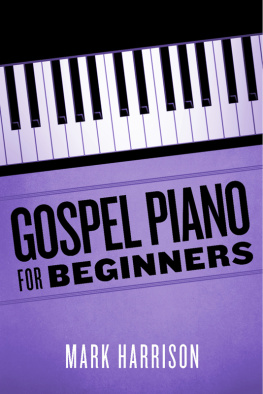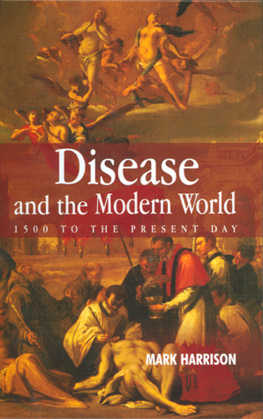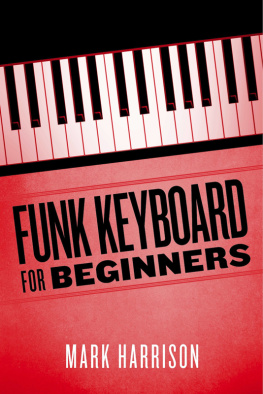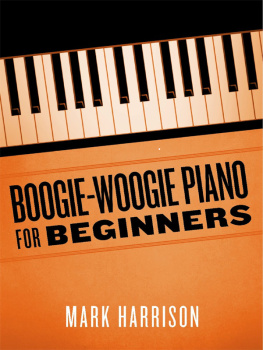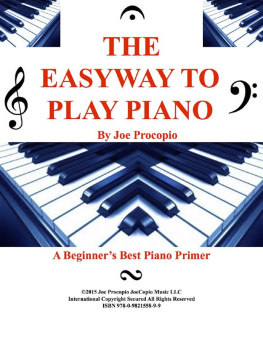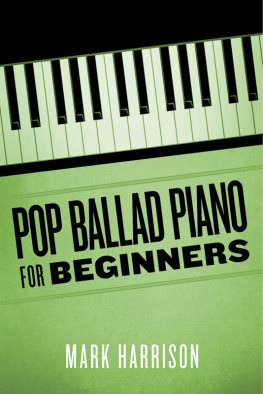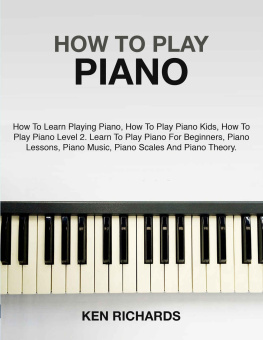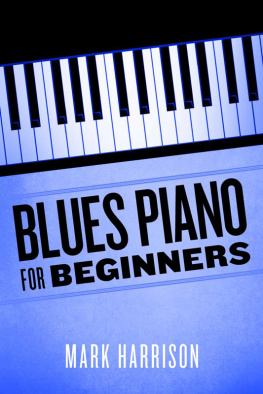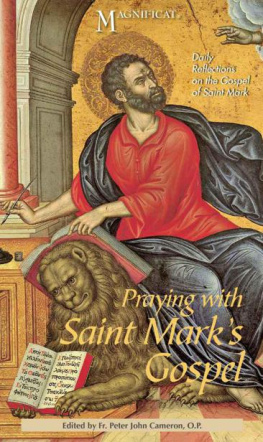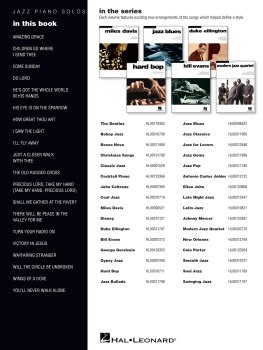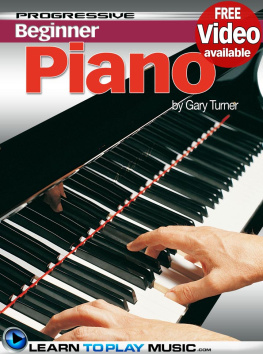

Published by: Harrison Music Education Systems, P.O. Box 5068, West Hills, CA 91308, USA
Publication date: 05/01/13
Copyright: 2013 Mark Harrison
ISBN Number: 9781626757134
For information on our music education books and CDs, downloadable products and packages, and private on-line lessons, please visit our website: www.harrisonmusic.com
Welcome to Gospel Piano For Beginners. This book will start you on the road to playing authentic gospel piano, even if you are a complete beginner. Youll get started right away by learning some essential gospel grooves which will help you lead your first (or next) congregation at the piano. These patterns will also help you add that gospel feeling to your rock and R&B playing!
Please email us at with Gospel Piano For Beginners in the subject, to receive your FREE mp3 audio recordings of all the music examples in this book! Most of the audio recordings feature a rhythm section on the left channel, and the piano on the right channel. To play along with the band, turn down the right channel to eliminate the recorded piano. To hear the piano part for reference, turn down the left channel to eliminate the rhythm section.
Along with your free mp3s, you will also receive free pdf versions of all the music notation examples. So if your e-reader does not display the notation examples clearly enough, you can use the pdf versions as a convenient alternative.
Well start off with some basic gospel comping patterns in 3/4 time (this means there are three quarter note beats in each measure). Songs using the 3/4 time signature are very common in traditional gospel and church settings. In case you didnt know: comping is musician slang for accompaniment so comping patterns are what you would use to accompany yourself singing (or to accompany other singers or instrumentalists). Lets jump right into our first gospel comping pattern, which has a swing eighths rhythmic feel:
Example 1

These 3/4 time patterns use eighth notes, and you can see the eighth-note rhythmic counting (1 & 2 & 3 &) shown above the staff. This is how eighth notes are counted in 3/4 time, with the 1, 2, and 3 falling on the downbeats, and the &s in between falling on the upbeats. Suggested fingering numbers are shown on the staff (1 = thumb, 5 = pinky): however, these are only a guide, and valid alternate fingerings will exist in many cases.
In this swing eighths example, all of the &s actually land two-thirds of the way through each beat, giving the rhythm a more loping or shuffle type of feel. Count along to the mp3 audio track accompanying this example, to get comfortable with this rhythmic idea. All of the 3/4 time music examples in this book (Examples 1 12) have a swing eighths feel, which is very common in traditional gospel styles.
Note that above the first measure, the G chord symbol is shown. This denotes a G major triad (spelled G B D). In the first measure, the right hand is playing a G major triad on beats 1 and 3. However, at the end of this measure we are briefly moving to a C major triad in the right hand, before moving back to the G major triad in the next measure. This C major triad (spelled C E G) has been inverted, so that the fifth of the chord (G) is on the bottom this is called second inversion. Using this inversion enables us to move more smoothly between this C major triad and the adjacent G major triads in root position - this is referred to as voice leading.
Theory note: Although we are playing the C major triad briefly before returning to the G major triad, we are not showing a C major chord symbol above the staff. The C major triad is heard as a harmonic embellishment within the overall G major chord, and is not a chord change as such. With resepect to the G major chord, we are moving I - IV - I (one to four and back to one again) within the chord. This is sometimes referred to as backcycling, and is a staple ingredient of gospel piano.
In the first two measures of Example 1, the left hand is simply playing the root of the overall chord (G), using the same rhythm as the right hand part. In the last two measures, the left hand is adding the higher notes D E D above the root (doubling the highest note in the right hand triads, one octave lower) to create a thicker texture.
Next well apply these right hand triads and backcycling techniques to a simple I IV V progression in the key of G. Another quick theory note: the first, fourth and fifth degrees of the G major scale are G, C and D respectively. So if we build major triads from each of these root notes, we get a I IV V triad progression in G. To put a gospel twist on it, we might then add a backcycling triad movement to each of the I, IV and V chords, as follows:
Example 2


In the above example, measures 1 2 and 7 8 are the same as measures 3 4 in Example 1. In measures 3 6, the same backcycling technique is applied to the C major and D major chords, i.e. we are moving from one to four and back to one again within each chord. Again, check out the mp3 audio track for this example as needed (especially if your note reading is at a beginning level!)
Next were going to develop a very important gospel piano technique, referred to as Mixolydian triads. This simply means using triads derived from Mixolydian modes. We need to work through a little theory to make sure you understand this...trust me, itll be worth it! First well see how to displace a C major scale to create a G Mixolydian mode:
Example 3

In the first measure, we have a C major scale (C-D-E-F-G-A-B-C from left to right). Note that all major scales (including C major) are spelled using whole-step, whole-step, half-step, whole-step, whole-step, whole-step, and half-step intervals in an ascending sequence.
In the second measure we have displaced this C major scale to start on the note G. Any major scale re-positioned to start on its 5th degree is known as a Mixolydian mode. Therefore we have created a G Mixolydian mode here. You may know that this is equivalent to taking a G major scale and flatting (lowering) the 7th degree by half-step, i.e. in this case flatting the F# to an F natural - this is an alternative way to create the Mixolydian mode.
The critical point relating to gospel and blues styles, is that this G Mixolydian mode is a scale source (the scale containing all of the notes) for a G dominant 7th chord, which as you may know is spelled G B D F. Dominant chords are a vital ingredient in gospel styles, and well now see how to use triads within the Mixolydian mode, as embellishments over these chords.
If we were to build triads from each degree of the C major scale, and stay within the scale restriction, you may know that we would get C major, D minor, E minor and so on (these are known as diatonic triads). So we could do the same thing using a G Mixolydian mode, as this is just a displaced version of a C major scale:
Next page
